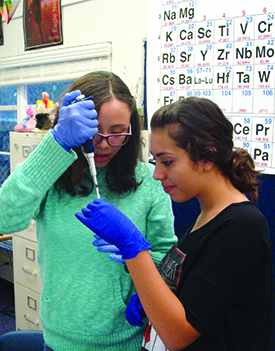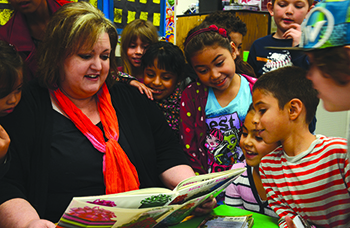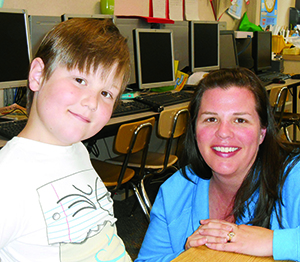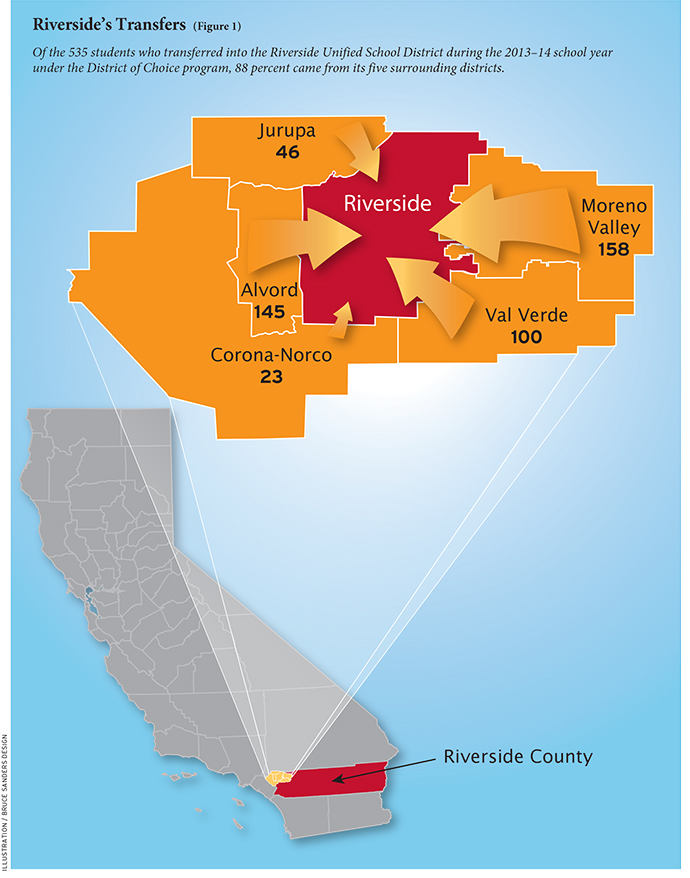The Riverside Unified School District in California’s vast inland empire east of Los Angeles took advantage of a new state law in 2010 and declared itself a District of Choice. The designation meant that children from any other school district could transfer to Riverside without first getting approval—or even seeking it—from their home districts.

(Photo/Courtesy Riverside STEM Academy)
Soon after, and as part of a broader school-board decision to expand school-choice options, the district launched a science and technology middle school, a dual-language immersion elementary, an all-digital high school, an arts-centered grade school, a virtual school starting at grade 3, and more. Kids from other districts could enroll in the new programs, or, if the programs were oversubscribed, could enter admissions lotteries and, in some cases, stood the same chance of winning as Riverside youngsters.
In the first year, 161 students switched to Riverside under the District of Choice program. In the 2012–13 school year, 395 transferred, and in 2013–14, another 535 arrived (see Figure 1). Riverside, which had been losing enrollment as its surrounding community aged, has seen a modest rise to about 42,200 students, and with that, an increase in its per-pupil-based state funding.
“Does it make money? No. But does it keep our people employed? Yes. Does it keep our financial situation stable? Yes. Does it increase educational options? Yes,” says Timothy Walker, who oversees the program at Riverside.
The District of Choice law was meant to encourage districts to compete for students by offering innovative programs and this-school-fits-my-child options that parents want. The law “could open a new era of entrepreneurship in education in which schools improve their programs in order to retain and attract students,” the Los Angeles Times editorialized.
So how many of California’s 1,000-plus school districts have declared themselves Districts of Choice?
Perhaps 31.
Mixed Motivations
The notion that youngsters can leave their school for one they like better in a neighboring district began in 1988 in Minnesota and has since spread in some form to nearly every state, according to the Education Commission of the States. Those forms vary widely, though, from highly proscribed transfer opportunities to open enrollment. Admissions preference may be given to children in low-performing schools, or to children who will increase diversity in their new school, or, in less-populated states, to those who live closer to an out-of-district school than to one that is in the district. Nebraska limits interdistrict choice to the Omaha area. In Indiana, Maine, and Missouri, parents may have to pay tuition when they transfer. In Georgia and Montana, among others, districts can charge each other tuition. And in most states, including California, parents are responsible for their kids’ transportation.
In other words, interdistrict choice isn’t an easy avenue for most parents to navigate, and few districts see any advantage in promoting it and threatening their monopolies.
Interdistrict choice has been more common in California than in other states for a variety of reasons. The Golden State’s school districts generally are small (there are 23 just in Riverside County), so driving to a neighboring district usually adds only marginally to Californians’ already awful commutes.
Districts don’t follow city or community boundaries, or reflect any neighborhood identity that transfers would disrupt. And most significantly, money follows the child more than in most states. All but the wealthiest districts receive their funding entirely from the state rather than from local taxes, a consequence of the 1978 Proposition 13 tax initiative that left local authorities with little ability to raise revenues.
Interdistrict transfers generally need the yearly approval of the district that a youngster is leaving and of the district he is entering. For years, districts were sympathetic to transfer requests from parents who wanted their children in schools along their own commuting paths or near afterschool care. In the 2012–13 school year, Riverside approved 1,813 of those transfers into the district and 743 transfers out.
But as districts have seen their budgets squeezed and their enrollments fall—California’s enrollment dropped 2 percent between 2003 and 2010, and about half its districts are losing enrollment—many have become reluctant to let children go.

(Photo/Courtesy Bryant School of Arts & Sciences)
Tabitha Brown, the mother of two youngsters in Riverside’s Bryant elementary, told me that administrators in her home district refused to allow her to transfer the children there unless she could prove that Bryant offered a curriculum that none of her district’s schools had. “I can’t tell you how many times I went to the registrar’s office” to get a release, she said, despite Riverside’s District of Choice status. (Riverside administrators finally stepped in to resolve the dispute, she said.)
Parents can appeal a transfer denial to a county school board, but there is little consistency between one county board’s rulings and those of its neighbors, or even between one appeal and another.
In 1992, the California legislature passed a law that allowed a small number of districts to bypass the whole application process, and in 2009, it extended that law to any district in the state. With a simple vote of its school board, a district now can declare itself a District of Choice, allowing it to accept as many transfer students as it chooses. For the most part, “home districts” can’t refuse to let their youngsters go, and, once accepted under the choice program, families don’t need to apply ever again.
Among the few rules: Districts can’t target youngsters, like athletes or math whizzes. Transfers can’t exacerbate racial segregation, and a district can’t take so many students that the transfers undermine another district’s financial stability. And Districts of Choice can’t reject special education students, English-language learners, or, in most cases, youngsters whose educational needs will cost more to address than the state funding they bring with them.
Soon after the law’s passage, the Association of California School Administrators urged districts to “do a self-examination” to understand why kids might want to transfer. It recommended they “build attractors” that might make kids want to come. And it suggested they sign “interagency agreements” with neighboring districts to regularize the flow of students. “This is not a time when we want districts behaving like cannibals,” the association paper cautioned.
Michael Kirst, an emeritus Stanford University education professor and president of the California State Board of Education, told me he thought the program would spur innovation. “Rational economic theory” suggests that districts will be motivated to become Districts of Choice, he said. The only way they can cushion their budgets is to attract more students, and one way to do that is to introduce the kind of programs that parents increasingly say they want for their kids.
“I thought this would do things, but it has faded into the woodwork,” he said. “I don’t even hear it discussed,” added Adonai Mack, who coauthored the school administrators’ paper.
Options Attract
Riverside’s enrollment had dipped to 40,677 in 2010, down 231 students from the year before. Meanwhile, because of the recession, state funding had dropped by $100 million, or about 30 percent of the district’s annual budget. Anticipating further enrollment declines, “we were looking for ways to market ourselves to parents outside,” Tim Walker, the district’s director of special services, told me. When the legislature passed the District of Choice bill, “we jumped right in,” he added.
Riverside’s board voted to accept up to 500 transfers in 2011 under the new program. At the same time, it decided to expand the learning options at its 48 schools, all of which were then neighborhood schools with neighborhood boundaries. Superintendent Rick Miller told me he wanted “a more open-market environment,” and urged his principals to find ways to make their schools distinct. (Miller himself transferred to an Orange County school district soon after we spoke.)
The district’s Bryant elementary was among the first two schools to take the leap. An aging, concrete-block low-rise, Bryant had seen its enrollment decline with its test scores. Of 29 elementary schools in the district, it ranked 27th based on California’s Academic Performance Index, or API, and was 190 students under capacity.

Principal Lari Nelson bought a $750 newspaper ad that winter, hung banners from the school, and sent out an automated phone message to the district, all announcing that Bryant was adopting the Core Knowledge curriculum and would hence be known as the Bryant School of Arts and Innovation. “The word started getting out, and we’ve been full ever since,” with 460 youngsters enrolled in 2013, Nelson told me.
Classical music was playing in the school yard when I arrived one morning. A class of 2nd graders was learning the difference between treble and base clefs. One of 17 classrooms was devoted to arts education (Gauguin was the “artist of the month”), and every youngster had a laptop or tablet. Bryant’s score on the 1,000-point API has risen to 820 from 727 four years ago, even though 81 percent of its students qualify for free or reduced-price lunch and 23 percent are English-language learners.
Katie Demick told me she transferred her son, Xander, to Bryant from his home district that first year, aware of Bryant’s low test scores, its dicey neighborhood, and the grinding commute she was in for. (Riverside doesn’t provide buses for either in-district or out-of-district transfer students.) “It’s a tank of gas every four days,” she said, but “I was excited about the arts and the music.”

This year, 101 students are transfers, 20 from outside the district, the rest from outside the neighborhood. With Bryant full, Riverside has opened a Core Knowledge program at a second school, and Demick enrolled her younger son there. “I don’t know anything that’s wrong” with their home district, she said. “It just didn’t offer as much.”
Riverside’s Academy of Sciences, Technology, Engineering, and Math middle school also opened in 2011. Sharing space with another school, it immediately filled with 200 youngsters, moved to its own campus the next year, and just as quickly filled with 470 students, and has another 272 students currently on the waiting list. For the 2013–14 school year, 572 youngsters applied for 221 openings, 13 percent of them from outside the Riverside district. A televised lottery now determines who gets in.
Carl Rowe, who owns a string of day-care and assisted-living facilities, described sitting with his daughter, Rosemary, in the front row of the drawing in 2012 until her number was called, the 95th of 105 youngsters accepted in 5th grade that year. “I want my daughter to be competitive on a global stage,” Rowe told me (the academy has an API of 974). But their home district, next door to Riverside, was “mediocre at best,” Rowe said, and Rosemary had been attending private school.
We were speaking in a conference room where Azin Mobasher was straightening boxes of snacks and PTA supplies. A microbiologist, Mobasher, and her husband, who is an astrophysicist at the nearby University of California, Riverside, live in the district but also had been sending their two children to private schools before winning the STEM academy lottery (their daughter first spent a semester on the wait list).
In addition to drawing youngsters away from private schools, the academy seems to be making neighboring districts take notice. A spokesman for the county school board recently told the local newspaper that “almost every” district has STEM program planning under way. “A lot of districts tell parents they’re starting a STEM” as an inducement to stay, David Mendoza, a software executive with two out-of-district children in the academy, told me.
In part, that sudden interest in a STEM program likely reflects the direction of the 21st-century job market. But competition from Riverside’s STEM academy may be another reason. “I’m sure that’s some of it,” Dale Moore, the academy’s principal, told me. “We’re helping catalyze that interest.”

Cannibals and Interlopers
The California law doesn’t require a district to tell the state education department if it decides to become a District of Choice, which means that nobody officially tracks the program. The only person I found who even counted the participating districts was Jon Duim, a principal in Oak Park Unified School District, north of Malibu, for his 2013 dissertation for the University of Southern California. Duim reasoned that any district that adopted a choice designation would be advertising for students on the Internet. Scouring the web, he found 31 districts. Of those, 2 had enrollments of more than 15,000, 10 had enrollments of fewer than 1,000, and a few were one-school districts.
A flaw in the California law, Stanford’s Michael Kirst told me, is that it didn’t respond to pressures from school districts or boards, or didn’t address any of their concerns: it wasn’t their idea. Instead, it was the idea of several state legislators, who offered no incentives and, for the most part, have since left office. “It’s a lack of demand at the local level,” Kirst said. “There’s no bottom-up support.”
Beyond that, the choice option doesn’t work for every district. Growing districts may already be coping with crowded schools. Big districts may decide that the added funding brought by a few more kids isn’t worth their while. Wealthy districts that get additional funding from their taxpayers aren’t likely to want to share it with out-of-district kids. Low-performing districts know they don’t have a lot to offer.
The law also has caused tensions among superintendents, who do indeed see choice districts as cannibals. “It’s a professional norm that you don’t try to poach students from other districts,” Kirst said.
Superintendents “don’t want to upset their colleagues,” particularly if it’s for their own district’s financial gain, said Adonai Mack, of the school administrators association. It also “could be,” he went on—yes, indeed it could—that many superintendents “aren’t entrepreneurial.”
“They’ve always had a monopoly,” one superintendent in a choice district told me, after asking for anonymity. “My colleagues don’t like this.”
That tension was exposed by a 2010 suit filed by Rowland Unified School District, a 13-square-mile sliver of Los Angeles County with 15,000 students and an API of 807, against Walnut Valley Unified, a neighboring nine-square-mile slice with 15,000 students and a 909 API. Rowland argued that Walnut Valley, a District of Choice, had taken 742 Rowland students and that that was quite enough. After two years of legal wrangling, a state appeals court agreed, citing that rule against undermining another district’s financial stability.
The choice law isn’t entirely popular with choice-district parents either, especially if they see transfer students taking seats in popular programs. Riverside gives admissions preferences to in-district kids over out-of-district students, except at its STEM school, where both enter the same lottery. “This is hard for some of the parents in our district to accept,” Dale Moore, the principal, said. One-quarter of his 5th graders are now transfer students.
It’s also hard when parents assume that transfers add a tax burden. A posting on a Walnut Valley message board that I perused harrumphed that “You shouldn’t have a right to apply for a school you do not financially support.” Said another, “Yes, please bring in unsafe traffic and poor kids from Rowland Heights and Pomona so we can subsidize their education.”
To counter that argument, Oak Park Unified, Jon Duim’s district, includes a frank “District of Choice Fact Sheet” on its web site. It reports, among other things, that without its 1,963 transfer students—who, Oak Park said, generate the same $5,537 in revenue as in-district kids—it would have to close an elementary school, limit Advanced Placement and honors programs, scale back arts programming, and increase class sizes. The result could be a “downward spiral” that eventually would see “home values decline,” it warns.
Oak Park also addresses the fear that transfer students will lower test scores, and with them, yet again, those home values. Its transfer students score about the same on language arts, exactly the same on grades 2 through 7 math, slightly lower on “general math,” and slightly higher on Algebra I, it reports.
Indeed, Duim found that choice districts had higher API scores than the state generally: 833 to 788. Logically, if a choice district “isn’t attractive, families won’t take advantage of it,” Duim said. Choice districts “trade on their good reputation.”

(Photo/Courtesy Bryant School of Arts & Innovation)
“Just More Options”
Back in Riverside, I next visited Washington elementary, the first of three English-Spanish immersion schools that the district has opened in three years. “We thought parents would want to see the program” before enrolling, Pati DeRobles, the district’s dual-language immersion coordinator told me. “But they wanted us to stop talking. ‘Just tell us how to get in,’ they said.”
From there, I visited Ramona High School, a sprawling high-poverty campus that jettisoned its textbooks three years ago in favor of digital devices and saw its enrollment climb by 200 from a year ago, plus a 20-point increase in its test scores. “We’re known as the bottom. For kids to choose to come here…,” Monica Ward, an academic coach, said, as her voice trailed off.
My final stop was Riverside Virtual, where youngsters do most of their work off campus and online. Among the students at school that day was an 11-year-old violin and piano prodigy and YouTube sensation, who otherwise commutes to Los Angeles for music lessons.
Walker, the district’s director of pupil services, said he expects to process 10,000 transfer requests in the 2013–14 school year. That includes youngsters moving from one Riverside school to another as well as those transferring in or out, those on District of Choice transfers, and those on year-to-year approvals. That number will drop as kids settle into the schools they want to be in, and as the yearly transfers become aware of the Choice program and its one-time-only admissions procedure, Walker said.
Still, I asked him about the administrative costs of all that movement. “The cost is on the back side if you don’t do it,” he said. “If people aren’t where they want to be, they complain, it affects your reputation and the regard for the district among the public.”
“If you have good programs, it’s not what other districts are doing wrong,” he added. “There are just more options here.”
June Kronholz is an Education Next contributing editor and former Wall Street Journal education reporter, foreign correspondent, and editor.
This article appeared in the Summer 2014 issue of Education Next. Suggested citation format:
Kronholz, J. (2014). California’s Districts of Choice: A handful of entrepreneurial superintendents compete for students. Education Next, 14(3), 38-45.



